Influence of Ga Content on the Microstructure and Mechanical Properties of Cadmium-Free Filler Metal
Abstract
:1. Introduction
2. Materials and Methods
3. Results
3.1. Melting Temperature and Wettability of the Filler Metals
3.2. Microstructure of the Filler Metals
3.3. Microstructure and Mechanical Property of the Brazed Joints
4. Conclusions
- (1)
- The solidus and liquidus temperatures decrease with the addition of Ga in the low-silver filler metals, meanwhile, the wettability of 12AgCuZnSn-2In-0.15Pr-xGa is significantly improved. The wetting ring is found on the leading edge of the brazing alloy after the spreading test on 304 stainless steel, which overlaps with the element mappings of Ag, In, and Sn.
- (2)
- The 12AgCuZnSn-2In-0.15Pr-xGa filler metals are mainly comprised of an Ag-based solid solution, Cu-based solid solution, and CuZn compounds. Additionally, the network structure is observed in the filler metal with trace Ga addition. Moreover, some bright Ag-rich phases and gray Cu-rich phases are formed in the matrix when the content of Ga reaches 5 wt.%, and Ga prefers to form a solid solution with Cu, while the In element tends to dissolve into Ag.
- (3)
- Ga has a higher diffusion coefficient into 304 stainless steel than that of Ag, Cu, Zn, etc. The largest shear strength of the brazed joints is obtained when 12AgCuZnSn-2In-0.15Pr-1Ga filler metal was used, and the fracture morphology of the corresponding brazed joint exhibits a much finer and uniform dimple structure than that of the Ga-free one. However, the shear strength of the brazed joints decreases with further increasing Ga content.
Author Contributions
Funding
Acknowledgments
Conflicts of Interest
References
- Way, M.; Willingham, J.; Goodall, R. Brazing filler metals. Int. Mater. Rev. 2020, 65, 257–285. [Google Scholar] [CrossRef]
- Amelzadeh, M.; Mirsalehi, S.E. Dissimilar joining of WC-Co steel by low-temperature brazing. Mater. Sci. Eng. 2020, 259, 114597. [Google Scholar] [CrossRef]
- Lu, B.; Xu, C.; Yang, J.X. WEEE flow and mitigating measures in China. Waste Manag. 2008, 28, 1589–1597. [Google Scholar] [CrossRef]
- Ongondo, F.O.; Williams, I.D.; Cherrett, T.J. How are WEEE doing? A global review of the management of electrical and electronic wastes. Waste Manag. 2011, 31, 714–730. [Google Scholar] [CrossRef] [PubMed]
- Xue, P.; Zou, Y.; He, P.; Pei, Y.Y.; Sun, H.W.; Ma, C.L.; Luo, J.Y. Development of low silver AgCuZnSn filler metal for Cu/steel dissimilar joining. Metals 2019, 9, 198. [Google Scholar] [CrossRef] [Green Version]
- Wang, B.; Long, W.M.; Wang, M.F.; Yin, P.Z.; Guan, S.K.; Zhong, S.J.; Xue, S.B. Research progress in relation to composite brazing materials with flux. Crystals 2021, 11, 1045. [Google Scholar] [CrossRef]
- Cao, J.; Zhang, L.X.; Wang, H.Q.; Wu, L.Z.; Feng, J.C. Effect of silver content on microstructure and properties of brass/steel induction brazing joint using Ag-Cu-Zn-Sn filler metal. J. Mater. Sci. Technol. 2011, 27, 377–381. [Google Scholar] [CrossRef]
- Wang, H.; Xue, S.B. Effect of Ag on the properties of solders and brazing filler metals. J. Mater. Sci. Mater. Electron. 2016, 27, 1–13. [Google Scholar] [CrossRef]
- Wang, H.; Xue, S.B.; Wang, J.X. Study on the microstructure and properties of low-Ag Sn–0.3Ag–0.7Cu–0.5Ga solder alloys bearing Pr. J. Mater. Sci. Mater. Electron. 2017, 28, 8246–8254. [Google Scholar] [CrossRef]
- Luo, Q.C.; Xue, S.B.; Wu, J. Influences of Sn on properties of Ag-based and Cu-based brazing filler metals. Crystals 2021, 11, 1403. [Google Scholar] [CrossRef]
- Wu, J.; Xue, S.B.; Yao, Z.; Long, W.M. Study on microstructure and properties of 12Ag-Cu-Zn-Sn cadmium-free filler metals with trace In addition. Crystals 2021, 11, 557. [Google Scholar] [CrossRef]
- Karpiński, M. Microstructure of a joint of sintered carbides and steel brazed with Ag-Cu-Zn-Mn-Ni filler metal. Mater. Tehnol. 2020, 54, 485–488. [Google Scholar] [CrossRef]
- Zhang, G.X.; Long, W.M. Effect of trace element Ce, Sb and Li on wettability and oxidation resistance of silver-based brazing filler metal. Hot Work. Technol. 2011, 40, 4–6. [Google Scholar] [CrossRef]
- Ma, C.L.; Xue, S.B.; Wang, B.; Wang, J.X.; Hu, A.M. Effect of Ce addition on the microstructure and properties of Ag17CuZnSn filler metal. J. Mater. Eng. Perform 2017, 26, 3180–3190. [Google Scholar] [CrossRef]
- Wu, J.; Xue, S.B.; Zhang, P. Effect of In and Pr on microstructure and properties of low-silver filler metal. Crystals 2021, 11, 929. [Google Scholar] [CrossRef]
- Murray, J.L. ASM Handbook Volume 3: Alloy Phase Diagrams; ASM International: Novelty, OH, USA, 1992. [Google Scholar]
- GB/T 11364-2008; Test Method of Wettability for Brazing Filler Metals. Standardization Administration: Beijing, China, 2008.
- GB/T 11363-2008; Test Method of the Strength for Brazed and Soldered Joint. Standardization Administration: Beijing, China, 2008.
- Ma, C.L.; Xue, S.B.; Wang, B. Study on novel Ag-Cu-Zn-Sn brazing filler metal bearing Ga. J. Alloys Compd. 2016, 688, 854–862. [Google Scholar] [CrossRef]
- Wu, J.; Xue, S.B.; Wang, J.W.; Wu, M.F.; Wang, J.H. Effects of α-Al2O3 nanoparticles-doped on microstructure and properties of Sn–0.3Ag–0.7Cu low-Ag solder. J. Mater. Sci. Mater. Electron. 2018, 29, 7372–7387. [Google Scholar] [CrossRef]
- Wu, J.; Xue, S.B.; Luo, Q.C. Development of a novel low-silver Cu-P brazing filler metal bearing Sn. Crystals 2022, 12, 66. [Google Scholar] [CrossRef]
- Liu, H.; Xue, S.B.; Tao, Y.; Long, W.M.; Zhong, S.J.; Wang, B. Wetting behavior and vacuum soldering of novel Au-30Ga solder on Ni and Cu substrate. Vacuum 2020, 179, 109478. [Google Scholar] [CrossRef]
- Kogi, S.; Kajiura, T.; Hanada, Y.; Miyazawa, Y. Wetting and spreading behavior of molten brazing filler metallic alloys on metallic substrate. Mater. Sci. Eng. 2014, 61, 1757. [Google Scholar] [CrossRef]
- Lai, Z.M. Effects of Ga/In and Rare Earth Ce on Microstructures and Properties of Brazed Joint of 30AgCuZn Filler Metal. Ph.D. Thesis, Nanjing University of Aeronautics and Astronautics, Nanjing, China, 2011. [Google Scholar]
- Ji, F.; Xue, S.B.; Dai, W. Effects of Ti on the brazability of Zn-22Al-xTi filler metals as well as properties of Cu/Al brazing joints. Rare Met. Mater. Eng. 2013, 42, 2453–2457. [Google Scholar] [CrossRef]
- Kuryntsev, S.V.; Morushkin, A.E.; Gilmutdinov, A.K. Fiber laser welding of austenitic steel and commercially pure copper butt joint. Opt. Lasers Eng. 2017, 90, 101–109. [Google Scholar] [CrossRef]
- Kuryntsev, S.V.; Shiganov, I.N. Welding austenitic steel to copper with the defocused radiation of a fibre laser. Weld. Int. 2018, 32, 50–53. [Google Scholar] [CrossRef]

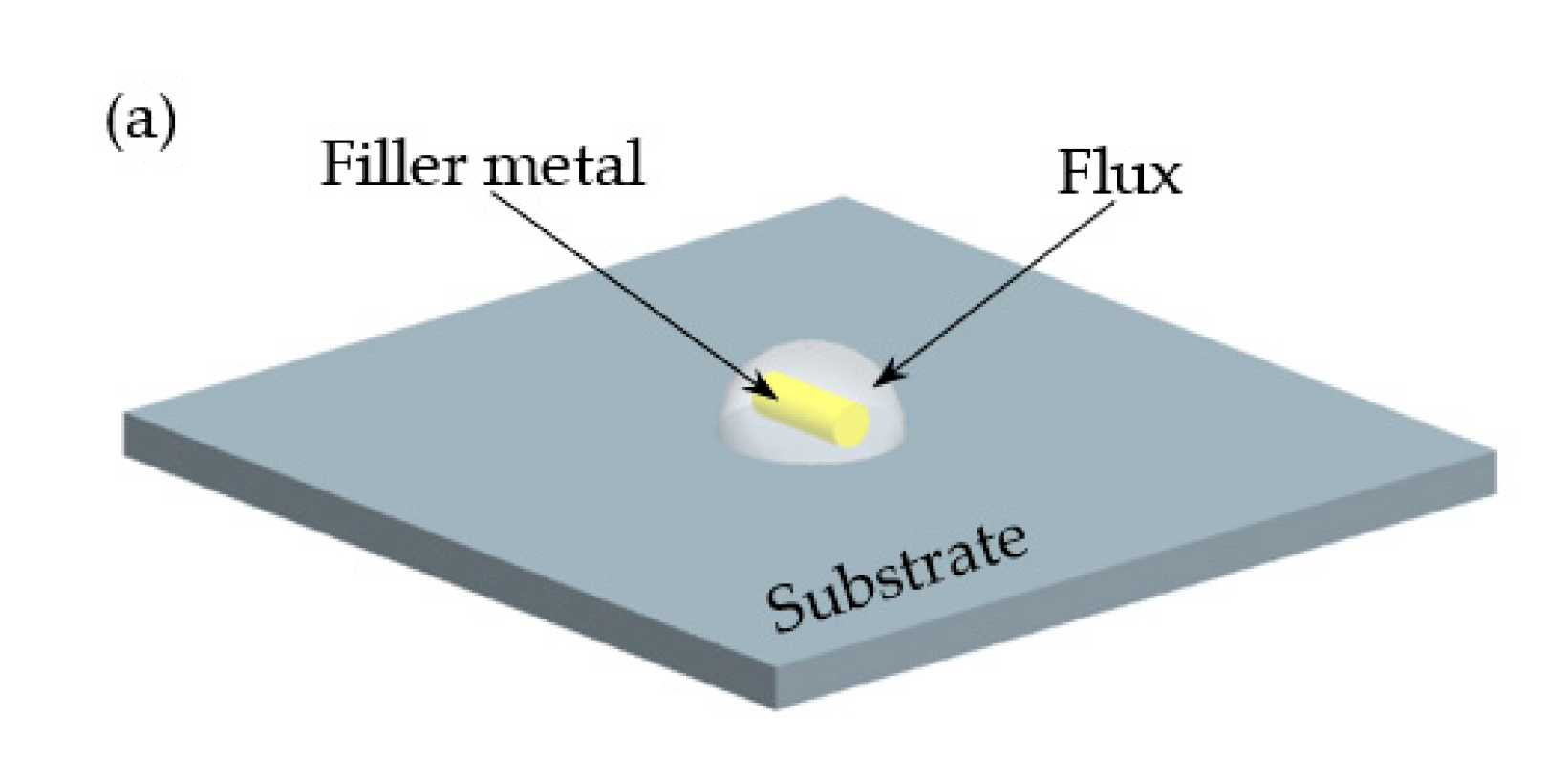

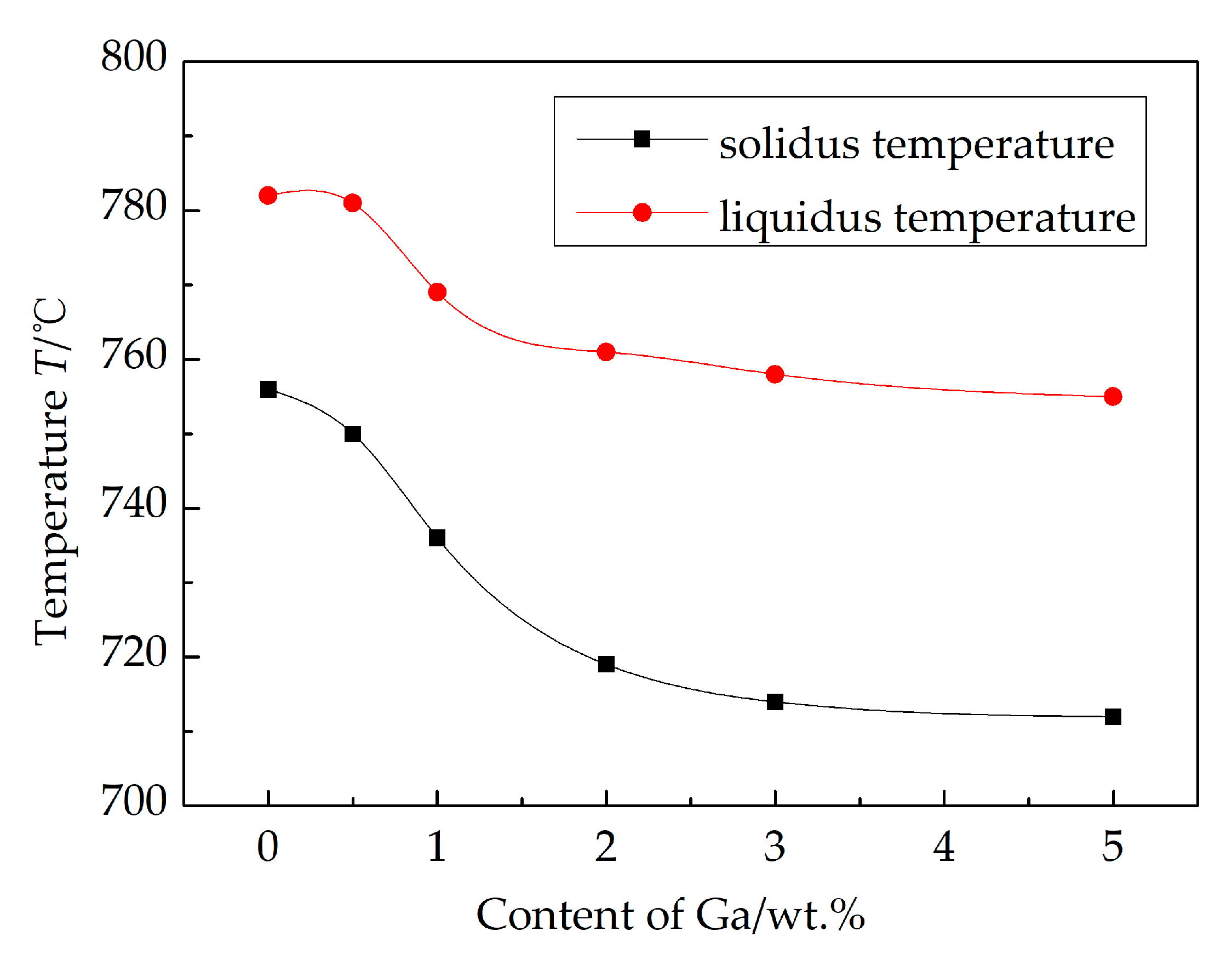

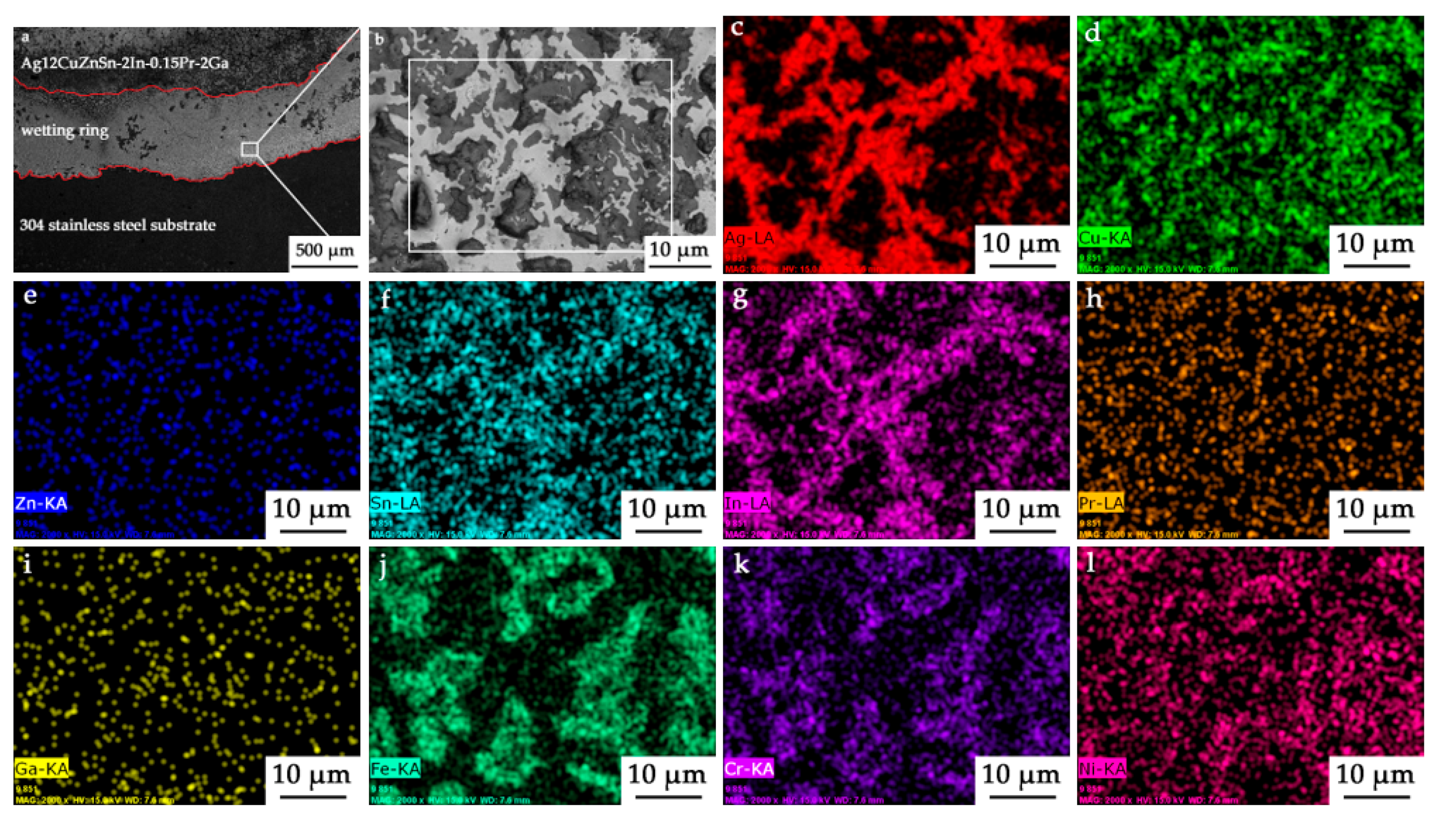
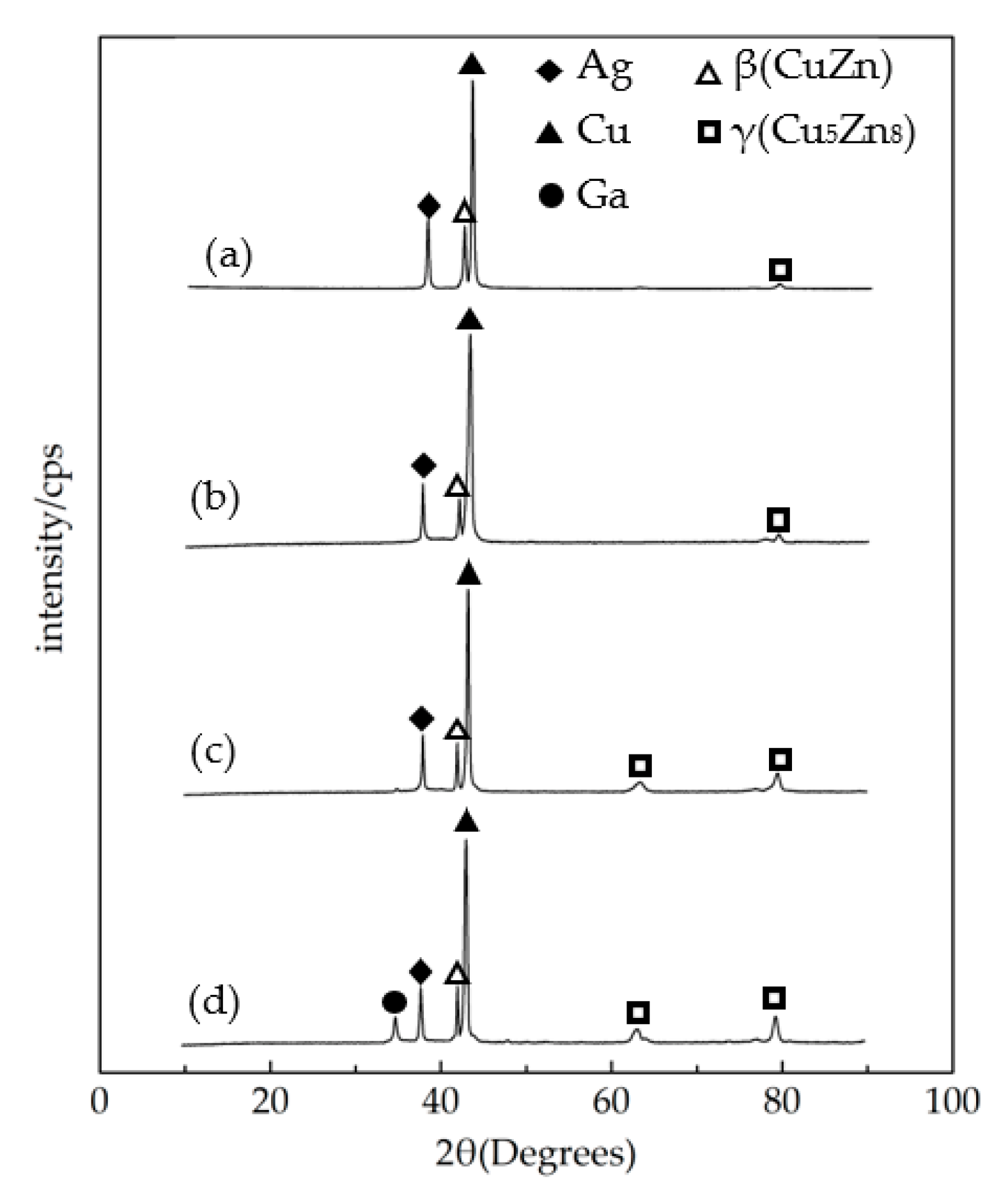

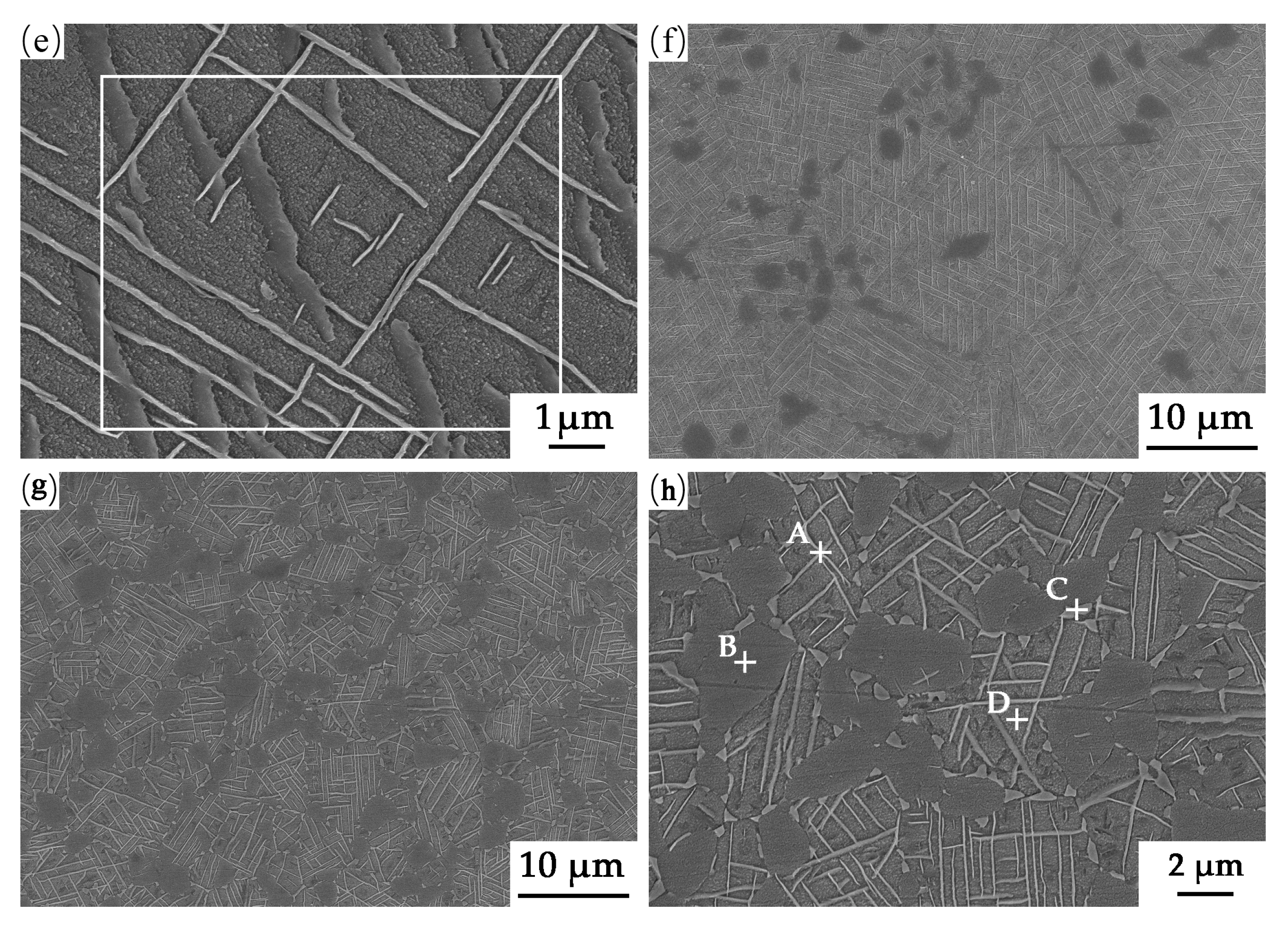

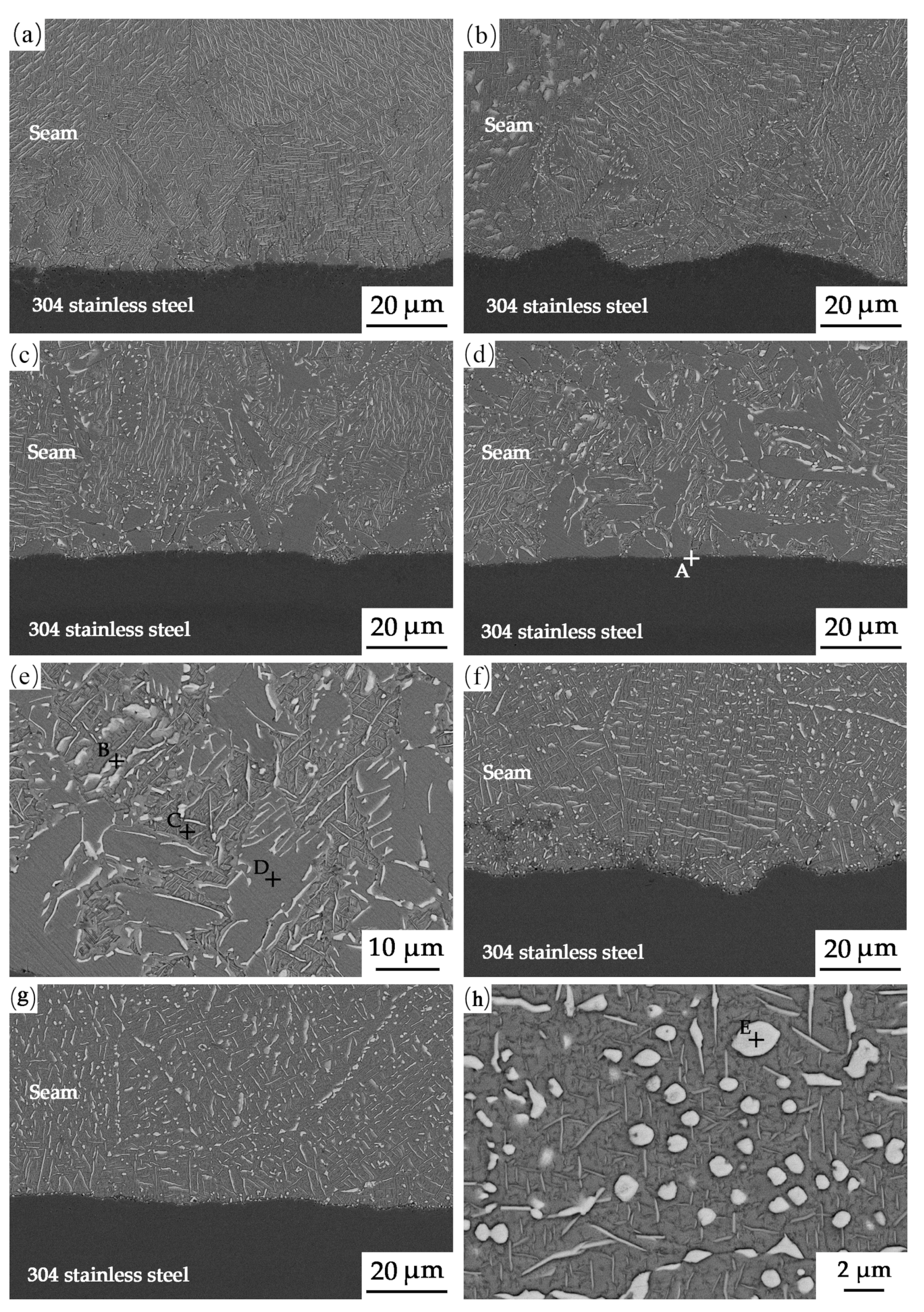
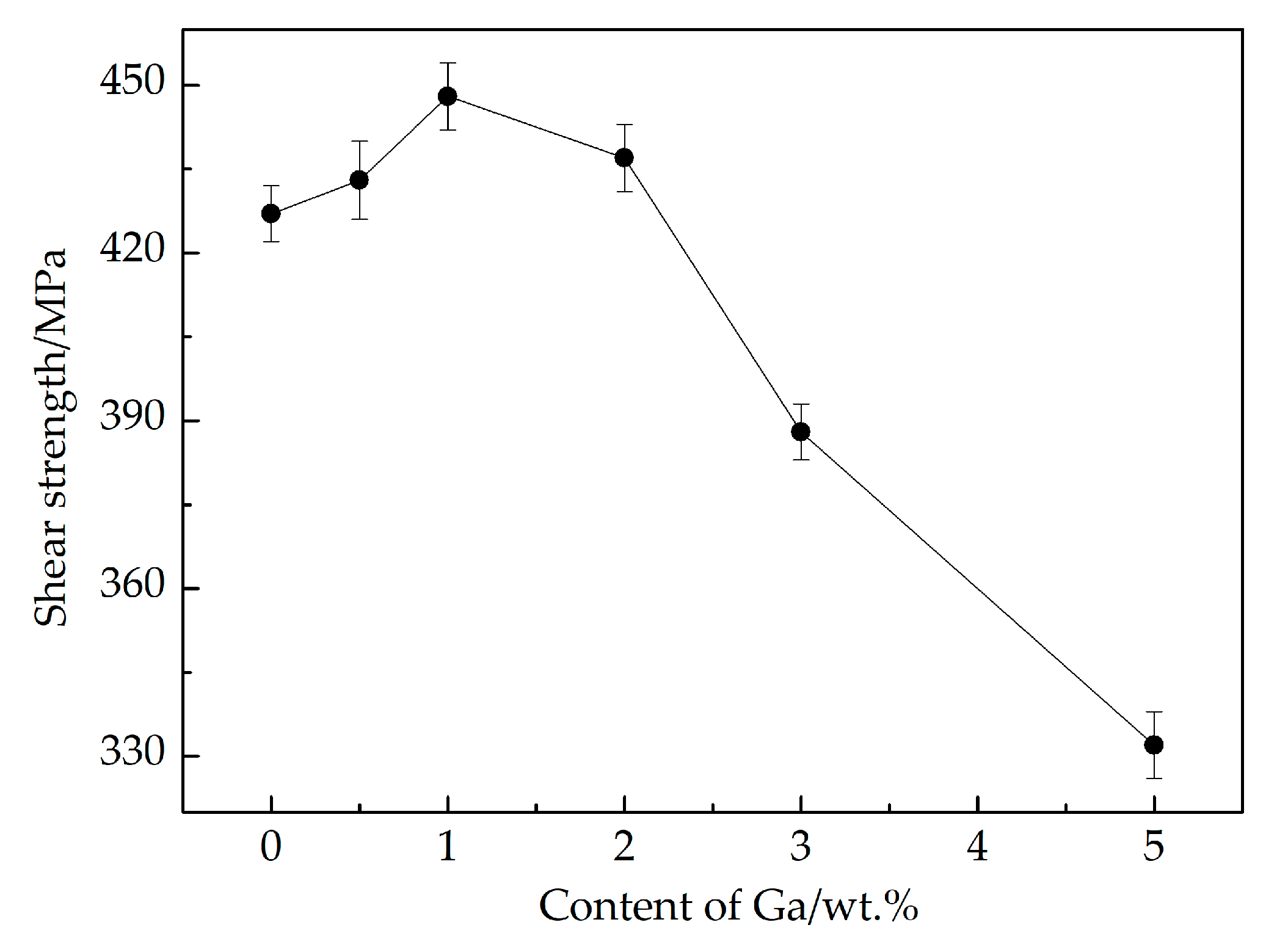

| No. | Ag | Cu | Zn | Sn | In | Pr | Ga |
|---|---|---|---|---|---|---|---|
| 1 | 12.0 | Bal. | 37.8 | 1.5 | 2 | 0.15 | 0 |
| 2 | 12.0 | Bal. | 37.5 | 1.5 | 2 | 0.15 | 0.5 |
| 3 | 12.0 | Bal. | 37.2 | 1.5 | 2 | 0.15 | 1 |
| 4 | 12.0 | Bal. | 36.7 | 1.5 | 2 | 0.15 | 2 |
| 5 | 12.0 | Bal. | 36.1 | 1.5 | 2 | 0.15 | 3 |
| 6 | 12.0 | Bal. | 35.0 | 1.5 | 2 | 0.15 | 5 |
| Points | Ag | Cu | Zn | Sn | In | Pr | Ga |
|---|---|---|---|---|---|---|---|
| A | 41.62 | 28.31 | 24.34 | 0.89 | 3.84 | 0.07 | 0.93 |
| B | 7.69 | 49.28 | 33.54 | 1.72 | 1.83 | 0.08 | 5.86 |
| C | 42.49 | 26.33 | 24.10 | 0.77 | 5.66 | 0.05 | 0.60 |
| D | 6.73 | 54.54 | 35.80 | 0.17 | 0.41 | 0.04 | 2.31 |
| Points | Ag | Cu | Zn | Sn | In | Pr | Ga | Fe | Cr | Ni |
|---|---|---|---|---|---|---|---|---|---|---|
| A | 1.01 | 2.89 | 2.49 | 0.06 | 0.14 | 0.02 | 3.42 | 70.79 | 14.87 | 4.31 |
| B | 37.54 | 31.84 | 25.06 | 1.25 | 3.18 | 0.06 | 1.07 | - | - | - |
| C | 8.97 | 51.80 | 35.36 | 0.97 | 1.35 | 0.07 | 1.48 | - | - | - |
| D | 6.40 | 58.24 | 32.21 | 0.42 | 0.71 | 0.04 | 1.98 | - | - | - |
| E | 65.64 | 9.68 | 12.91 | 1.10 | 10.65 | 0.06 | 0.09 | - | - | - |
Publisher’s Note: MDPI stays neutral with regard to jurisdictional claims in published maps and institutional affiliations. |
© 2022 by the authors. Licensee MDPI, Basel, Switzerland. This article is an open access article distributed under the terms and conditions of the Creative Commons Attribution (CC BY) license (https://creativecommons.org/licenses/by/4.0/).
Share and Cite
Wu, J.; Xue, S.; Liu, L.; Zhang, P.; Luo, Q. Influence of Ga Content on the Microstructure and Mechanical Properties of Cadmium-Free Filler Metal. Metals 2022, 12, 1151. https://doi.org/10.3390/met12071151
Wu J, Xue S, Liu L, Zhang P, Luo Q. Influence of Ga Content on the Microstructure and Mechanical Properties of Cadmium-Free Filler Metal. Metals. 2022; 12(7):1151. https://doi.org/10.3390/met12071151
Chicago/Turabian StyleWu, Jie, Songbai Xue, Lu Liu, Peng Zhang, and Qingcheng Luo. 2022. "Influence of Ga Content on the Microstructure and Mechanical Properties of Cadmium-Free Filler Metal" Metals 12, no. 7: 1151. https://doi.org/10.3390/met12071151






